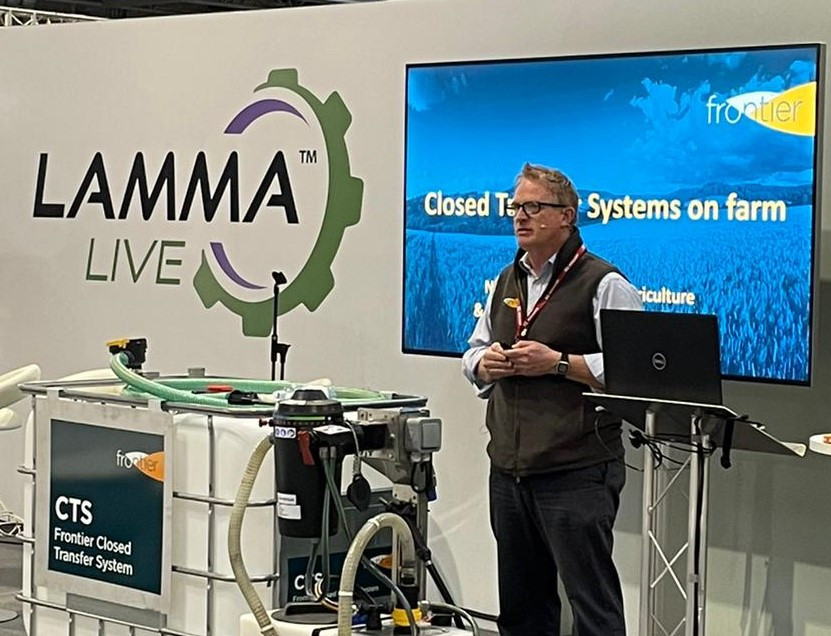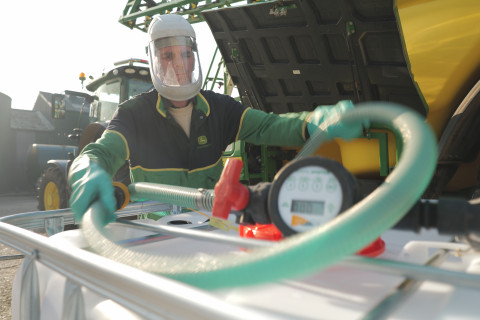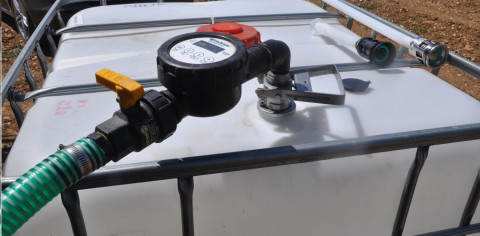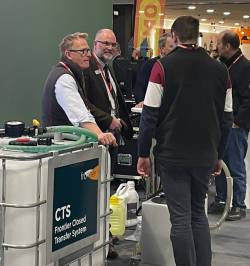Looking back to LAMMA: The benefits of a closed transfer system
Last month, I had the privilege of talking about Frontier's closed transfer system (CTS) at LAMMA as part of the event's Live Theatre sessions. I was thrilled to be able to bring this innovative piece of technology to the show, highlighting the benefits it's already bringing many farmers and sprayer operators at a time when on-farm safety, product stewardship and sustainable farming are extremely important.
While at the event, I had great conversations with visitors about the equipment – many of whom had questions about the technology as well as the practicalities of adopting it on farm. I thought it'd be great to reflect on these discussions here and explain why the closed transfer system is proving such a valuable solution for many growers.
Supporting sprayer operators
I've taken away many learnings throughout my time developing the CTS and LAMMA was no different. While talking to visitors, something that stood out to me - as it always does - is the commitment farmers have to looking after their sprayer operators. In many instances farmers are their own sprayer operator, which just highlights the amount of tasks they need to achieve.
A sprayer operator is a significant cog in the working machine that is a farm business. If you lose that cog, the farming system could be placed under a lot of pressure. I had many conversations with farmers about how important it is to equip themselves and/or their sprayer operators with the tools, technology and support they need.
Of course, sprayer operators are often under pressure to cover a large area each day in quite a specific window. Our CTS has been designed with these challenges in mind, omitting many of the tedious steps typically involved in the traditional ways of loading a sprayer while delivering an array of other advantages too.
What are the benefits being seen on farm?
The agricultural industry is under more scrutiny than ever to implement safer and more sustainable practices. As advisors and service providers, at Frontier we are committed through our wider sustainability strategy, 'The Responsible Choice', to support farmers with these responsibilities – which are ours too - and investments into innovations like the CTS mean we can provide the practical solutions to help.
During our time at LAMMA, Frontier crop production technical lead, Dr Paul Fogg, highlighted this commitment and covered three specific objectives the CTS is helping farmers and sprayer operators to meet.
1. Improved farm safety
According to the Health and Safety Executive (HSE)'s report around fatal injuries in ag, forestry and fishing in Great Britain April 2022 - March 2023, 27 people were killed in agriculture in 2022-23. This compares to the five-year average of 31. A stark and upsetting reality indeed, with many more injuries recorded each year with an estimated cost of around £190 million.
Everyone has a right to return home from work safe and sound. At Frontier, health and safety is our number one priority across all operations, so protecting and supporting those who play a critical role in our supply chains will always be paramount. The CTS is key to this, helping to protect operators by reducing manual handling and the potential for point-source contamination.
2. Increased farm productivity
With growing populations and increasing demand, there's pressure to deliver more from less in terms of what we can grow and how quickly.
The number of 'ideal' spray days are limited too – even more so when we consider the growing number of significant weather events disrupting the typical agricultural calendar. There's also the notable cost of application equipment today; amounting to a significant output for any farm business which makes optimising its use and maintenance hugely important.
The CTS improves overall sprayer output and efficiency thanks to operators spending less time filling and washing out empty containers.
It also has the potential to open doors for wider product choice and access. Crop protection products are heavily regulated and we have lost a significant number of active substances over the last 20-30 years. However, the CTS could start conversations around a more protected use of certain products that wasn't there before, such as extending the authorisations of any 'at risk' active substances given the improved management and control the CTS could provide. This could bring some products to market that may have otherwise not been possible to register.
3. Reduced environmental impact
Soil erosion, the leaching of fertilisers and run-off from crop protection products are all capable of impacting the wider environment and our communities if not managed responsibly. At particular risk are raw water sources, with agricultural practices and the protection of water quality always inextricably linked.
To better understand the challenges and therefore propose suitable guidelines around product and land stewardship, there has been ongoing work to try and quantify the pesticide losses from spray handling areas. In this report from the Crop Protection Association and Voluntary Initiative, it was established that as much as 40% of the pesticide load in some raw water supplies could be attributed to drips and spills due to 'poor practices in the handling area.'
Thankfully our industry and policy makers are taking progressive action, with schemes now available to support upgrades to handling areas. Examples of this are the Catchment Sensitive Farming (CSF) grants for the installation of biobeds/biofilters in areas where pesticides pose a potential risk to drinking water sources.
However, there's still more that could be done to safeguard the environment. At the moment, the only legal methods for removing used pesticide plastic containers are via specialised recycling or professional waste disposal. Both options are down to farmers to manage: either by paying to arrange for a recycling or waste disposal contractor, or by using a licensed disposal site (subject to availability and conditions for accepting such waste).
Against all these challenges, the CTS is a viable and important solution. I've mentioned already how the reduced manual handling lessens the risk of point-source contamination and exposure at filling, but this is also true when it comes to product storage and movement so that any risks of spills or leaks in handling areas are limited.
The CTS also reduces reliance on single-use plastic containers or IBCs - mitigating the potential impact of the Plastic Packaging Tax (PPT) for both product manufacturers and farmers.
Feedback and what's to come
While talking to the LAMMA Live audience, I mentioned that in the last two years we've seen over 500 growers adopt the FasTran 850 (a CTS for pack sizes 20 litre and larger) and many have stated they now prefer plant protection products (PPPs) and plant nutrient products in larger packs as a result. Operators that used the FasTran system are also requesting more products in large packs after experiencing a reduction in overall packaging, a safer way of loading the sprayer and an increase in hectares covered each day - typically 1-2 extra loads.
At Frontier, we currently offer 600 and 1000 litre CTS packs and we're continuing to work with crop protection and plant nutrient product suppliers to evolve this further. We're also exploring options for 30 and 50 litre containers, which will widen the opportunity for more products on farm.
How to use the Frontier FasTran 850 CTS
If, after learning about the benefits of the CTS, you are intrigued to know more about how it all works, you can hear from sprayer operator, Derick Oliver, in the video below. Continue through the playlist and you'll also hear from Richard Garnett of Wisdom Systems who developed the FasTran 850 CTS technology, as he talks through the set-up as well as ongoing maintenance during use.
CTS: supporting sustainable spraying operations
We're in no doubt that there's a long road ahead, but on-farm safety, sustainability, environmental protection and product stewardship are priorities for our industry. I'm passionate about the Frontier CTS and have been overjoyed to see the many ways it is helping farmers and sprayer operators around the country. With their feedback and the collaboration of others who are now adopting the equipment, I'm excited to keep developing this technology alongside more product manufacturers so we can continue to provide a practical solution that really delivers.
If you would like to know more about the Frontier CTS please visit our website, where you can also get in touch with our team. Alternatively, you can always speak to your Frontier contact.
As a subscriber, you’ll receive email alerts each time a new blog is published so you can always stay updated with the latest advice and insights from our experts








Comments